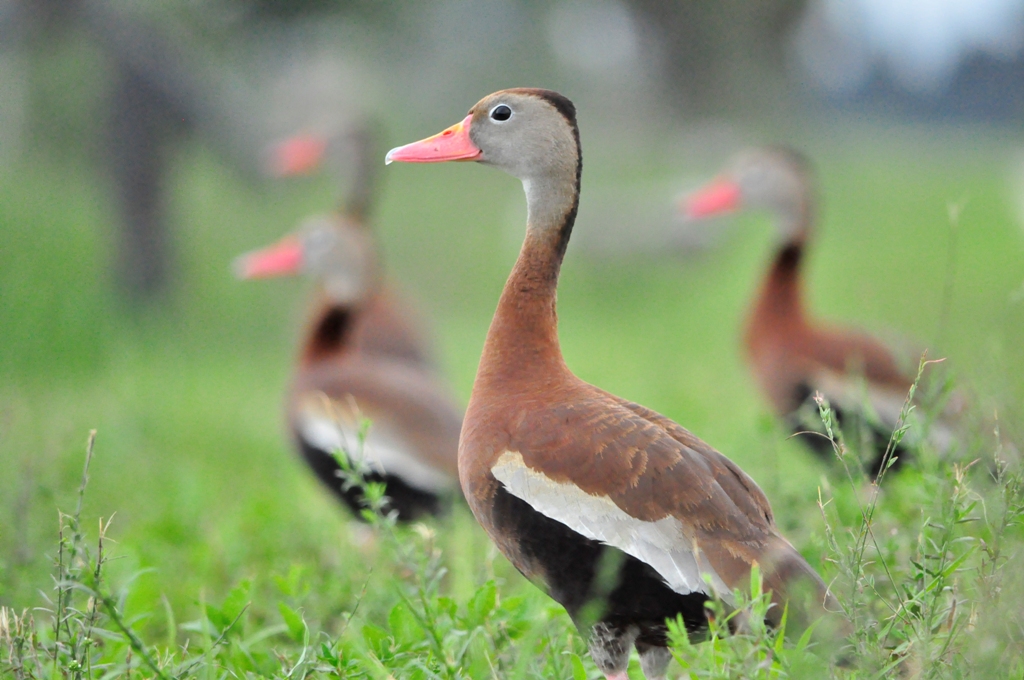
Black-bellied whistling duck, or Black-bellied tree duck(Dendrocygna autumnalis)
Phylum —chordata
Class — aves
Order — anseriformes
Family — anatidae
Genus –dendrocygna
Appearance
The black-bellied whistling duck is a mid-sized waterfowl species. Length ranges from 47 to 56 cm (19 to 22 in), body mass from 652 to 1,020 g (1.437 to 2.249 lb) and wingspan ranges from 76 to 94 cm (30 to 37 in). It has a long red bill, long head and longish legs, pale gray head and mostly gray-brown plumage. The belly and tail are black, and the body plumage, back of the neck and cap are a rich chestnut brown. The face and upper neck are gray, and they sport a thin but distinct white eye-ring. The extensive white in the wings is obvious in flight, less so on the ground; it is formed by the secondary remiges while the primaries are black; the wing-coverts are brown. Males and females look alike; juveniles are similar but have a gray bill and less contrasting belly.
Habitat
Black-bellied whistling ducks breed in southeast Arizona, coastal Louisiana and Texas through coastal Mexico and Central America to northern Argentina. A resident breeding population also occurs in Florida. This species is occasionally observed in eastern Texas, southern Louisiana, Mississippi, Alabama Georgia and South Carolina. Black-bellied whistling ducks winter from southern Texas southwards. Northern populations may be somewhat migratory moving southwards, but most populations are resident within their range.
Behavior
Black-bellied whistling ducks are highly gregarious (social) outside of the breeding season and are often seen flying in large noisy flocks.
Diet
Feeding often occurs at night, but can occur at any hour. Black-bellied whistling ducks eat a wide variety of plant materials, but will also consume insects and aquatic invertebrates when available. They often feed on submerged vegetation by wading in flooded fields or and other shallow water areas.
Reproduction
The black-bellied whistling duck is quite unique among ducks in their strong monogamous pair-bond. Its pairs often stay together for many years, a trait more often associated with geese and swans. Both parents share all tasks associated with the raising of young, from incubation to the rearing of ducklings. The ducks, primarily cavity nesters, prefer the confines of a hollow tree, but will nest on the ground when necessary. They also make use of chimneys, abandoned buildings, or nest boxes. Ducklings leap from nest cavities within two days of hatching, can feed themselves immediately, and stay with the parents for up to eight weeks.
In captivity
The maximum lifespan of a black-bellied whistling duck is 28 years.
Ducks feel great on the territory where there are tall grasses, shrubs and trees and a reservoir at least 1 m deep, the size of which allows them to swim. The area of the fenced yard should correspond to the number of birds contained, providing it with the opportunity to retire and hide. Small shelters on the top of the open area in the form of sheds, huts and booths are necessary as shelters from birds of prey, bad weather, as well as for overnight stays. Building aviaries, you should take into account the desire of the bird to fly. Owners usually cover them from above or make regular trimming of the wings.
In winter, ducks, being mainly tropical inhabitants, need reliable protection from the cold. Capital buildings with deep straw bedding or a thick layer of sawdust will protect the bird from hypothermia and frostbite in the winter. Depending on the severity of the climate, it is necessary to provide a variety of ways to warm up the winter room when the temperature drops from 0 оС and below.
It is quite simple to provide full nutrition to black-bellied whistling ducksin captivity. A variety of grain mixes and pellets are suitable for feeding them. Ducks need drinkers with a sufficient amount of clean water, especially if there is not even a small pond for swimming.
Ducklings grow well when the keepers start giving them standard feeds, and enjoy eating chopped lettuce or spinach leaves. Artificially bred сhicks sometimes do not eat well during their first days, so keepers add boiled eggs or mealworms to their food. It is important to provide pairs of ducks with a brood with the opportunity to graze on fresh grass or give access to shallow reservoirs overgrown with aquatic vegetation (duckweed, reeds, etc.). Such conditions of keeping contribute to better preservation and growth of young birds. Daily bathing under the control of adult birds is safe.
 Russian
Russian
 English
English


















